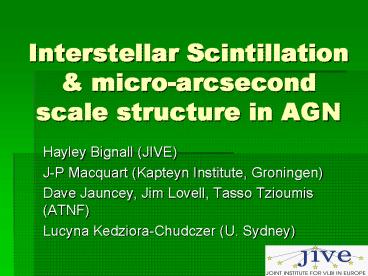Interstellar Scintillation
1 / 39
Title:
Interstellar Scintillation
Description:
Latest results for the fast scintillator, PKS 1257-326. Brief overview of last week's workshop ... 1984: 'flicker' - timescales 2-10 days at 2.7 GHz (Heeschen) ... –
Number of Views:52
Avg rating:3.0/5.0
Title: Interstellar Scintillation
1
Interstellar Scintillation micro-arcsecond
scale structure in AGN
- Hayley Bignall (JIVE)
- J-P Macquart (Kapteyn Institute, Groningen)
- Dave Jauncey, Jim Lovell, Tasso Tzioumis (ATNF)
- Lucyna Kedziora-Chudczer (U. Sydney)
2
Outline
- IDV and ISS some background
- Latest results for the fast scintillator,
PKS 1257-326 - Brief overview of last weeks workshop in
Dwingeloo Interstellar scintillation of
Extragalactic Radio Sources
3
Discovery of IDV
- 1984 flicker - timescales 2-10 days at 2.7 GHz
(Heeschen) - "Intraday variability" (IDV Witzel et al. 1986,
Heeschen et al. 1987) - Debate over origin intrinsic vs scintillation
4
(1966)
5
Regimes of scintillation
STRONG SCATTERING
WEAK SCATTERING
Fresnel scale rF(lL/2p)1/2
tref
Log time scale
tweak
tdiff
Log frequency
6
PKS 0405-385 the first intra-hour variable
- Kedziora-Chudczer et al. (1997)
8.6 GHz
4.8 GHz
2.3 GHz
1.4 GHz
7
PKS 0405-385 ISS model
RMS fractional variations as a function of
frequency
8
PKS 0405-385
- Rapid variability interpreted as interstellar
scintillation (ISS) by Kedziora-Chudczer et al.
(1997) - Still a high brightness temperature (D1000
required) using standard model of Galactic
electron density (TC93) - Model of Rickett et al. (2002) implies nearby
screen (3-30 pc) Tb reduced to 2x1013 K
9
PKS 1257-326 the third intra-hour variable
- The second well-studied IHV?! is J18193845
(Dennett-Thorpe de Bruyn, 2000), discovered
with WSRT - PKS 1257-326 was discovered serendipitously in
2000, in ATCA data at 4.8 and 8.6 GHz - ID quasar at z1.256 (Perlman et al. 1998),
B18.7 - X-ray flux 2x10-13 erg cm-2 s-1 (0.1-2 keV)
- Flat radio spectrum ltSgt 0.3 Jy
10
(No Transcript)
11
Two-station time delay
- Simultaneous VLA/ATCA observations
- Performed in 2002 May, 2003 Jan, March
- 2 consecutive days, 2 frequencies
- 4.86 GHz, 8.46 GHz, 100 MHz bandwidth
- Only 2.8 h common visibility low elevations
- Secondary calibrator PKS 1255-316 1o separation,
non-IDV (? 1), 2 Jy - Arcsecond-scale structure subtracted
12
(No Transcript)
13
(No Transcript)
14
Time delay, May 13-14 2002
VLA
ATCA
May 13, 4.9 GHz
May 13, 8.5 GHz
Flux density (0.2-0.4 Jy)
May 14, 4.9 GHz
May 14, 8.5 GHz
Time (4 hour range)
15
Time delay, Jan 10 2003
Jan 10, 4.9 GHz
Jan 10, 8.5 GHz
Flux density (0.2-0.4 Jy)
VLA
ATCA
Time (4 hour range)
16
Time delay, Mar 6-7 2003
VLA
ATCA
Mar 6, 4.9 GHz
Mar 6, 8.5 GHz
Flux density (0.2-0.4 Jy)
Mar 7, 4.9 GHz
Mar 7, 8.5 GHz
Time (4 hour range)
17
Fitting to a constant time delay (May data)
c2
Time delay (0-1000 s)
18
Fitting to a constant time delay (Jan data)
c2
Time delay (0-1000 s)
19
Fitting to a constant time delay (March data)
c2
Time delay (0-1000 s)
20
Flux density difference, before and after
applying time shift (March data)
21
(No Transcript)
22
4.8 GHz
8.6 GHz
23
(No Transcript)
24
(No Transcript)
25
Fitting time delay annual cycle
- Free parameters are
- Velocity of scattering screen (vRA, vdec)
- Characteristic length scale s0
- Axial ratio and position angle of anisotropy, R,
b - Data ? J-Ps fitting code combined c2
minimization ? fits! - (work in progress)
26
S01.5x105 km vRA27 km s-1 Vdec6 km
s-1 R10 B-40o
27
S0105 km vRA27 km s-1 Vdec6 km s-1 R5.6 B-40o
28
LSR
29
Implications
- If rF105 km at 4.8 GHz (l6.25 cm), then screen
distance L30 pc - For best fit, source cant be bigger than 100x40
mas ? Tb 3 x 1012 K
30
(No Transcript)
31
(No Transcript)
32
(No Transcript)
33
PKS 1257-326
- Combined time delay annual cycle is a neat
method of constraining scintillation parameters - Still much more to get out of the data! e.g
- intrinsic variations and frequency dependence
- polarization (cf Rickett et al. 2002)
- Behaviour of PKS 1257-326 is remarkably similar
to J18193845! - What makes these sources special?
34
- A small workshop held at ASTRON/JIVE, Dwingeloo,
the Netherlands, 5-7 April 2004 - SOC de Bruyn, Jauncey, Bignall, Macquart,
Gurvits - 25 participants, most gave talks
- Plenty of discussion time
35
Summary of ISS workshop
- Majority of presentations were on radio IDV/ISS
in AGN observations and theory/modelling. - Several presentations on VLBI results
- A few on the ISM, scattering screens
- Two talks on scintillation of GRBs
- All presentations will soon appear online at
http//www.jive.nl/meetings/iss_workshop - Some points of discussion
36
ISS workshop some of the topics discussed
- Lovell MASIV Survey 700 sources observed, only
one J1819! Are 1257 and J1819 special sources,
or on a special line-of-sight (or both?!) - Walker IDV scattering screens clues from
pulsar spectroscopy - Scintillation arc analysis (Stinebring et al.)
- Anisotropic scattering, thin screens
- Fast scintillators dont need special scatterers,
just local examples of a population which
pervades the Galactic disk - Other talks related to ISM/screens Cordes (the
Galaxy is grossly undersampled) Fuhrmann
37
ISS workshop some of the topics discussed
- Macquart diffractive scintillation in
J18193845 modelling implies minimum Tb 1015 K - Rickett scintillation arc analysis finds
different limits on source angular size - Conflicting results need to be reconciled
J18193845 dynamic spectrum
38
ISS workshop some of the topics discussed
- The (very few!) fast scintillators allow fairly
detailed modelling (Earth Orbit Synthesis), but
to do the same with the slower scintillators
requires much more dedicated observing - Jauncey monitoring programs like Ceduna, GAVRT
- Future instruments? The ATA, other SKA
demonstrators.
39
(No Transcript)































